tailgate FIAT TEMPRA 1988 Service And Repair Manual
[x] Cancel search | Manufacturer: FIAT, Model Year: 1988, Model line: TEMPRA, Model: FIAT TEMPRA 1988Pages: 171, PDF Size: 18.05 MB
Page 7 of 171
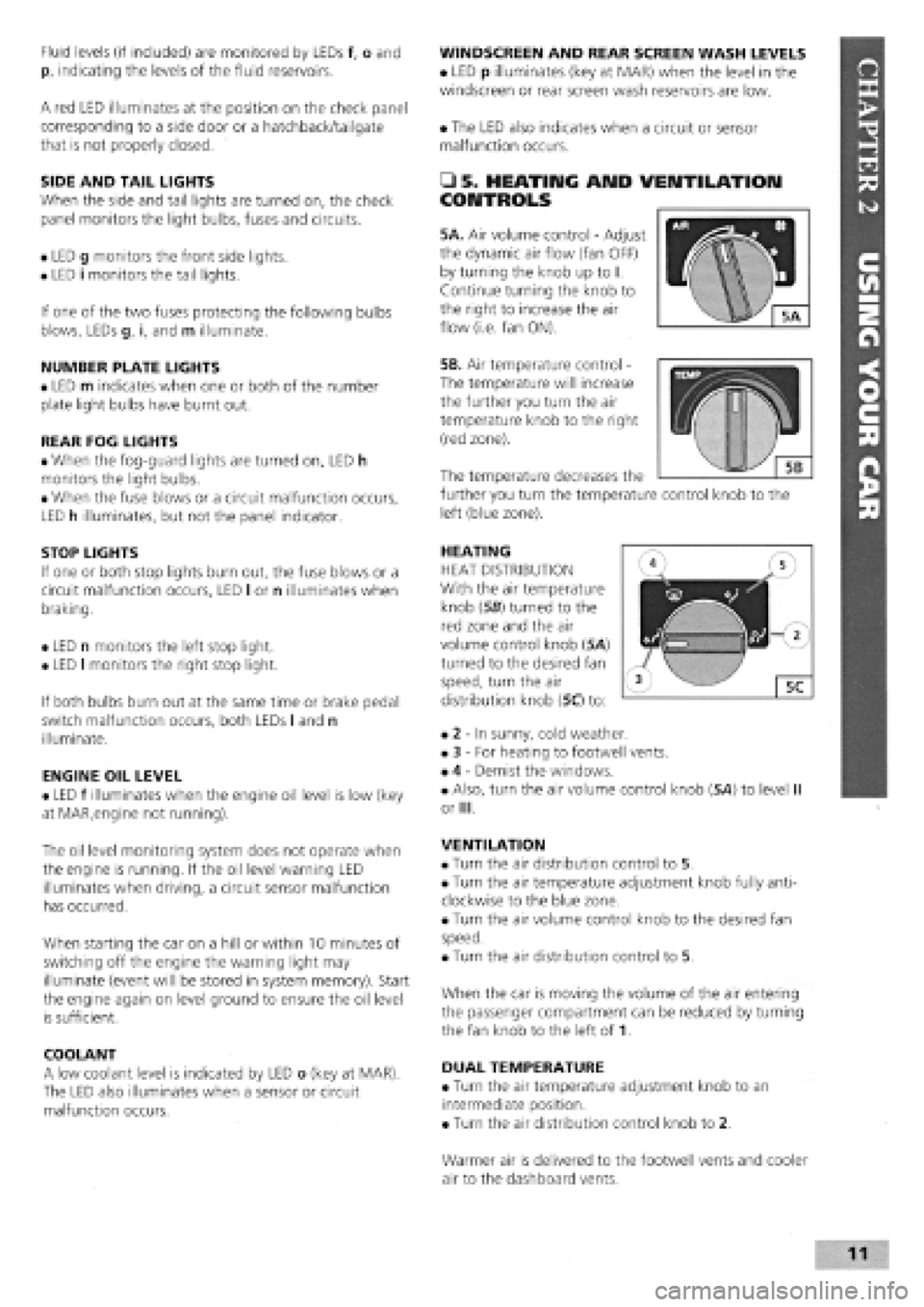
Fluid levels (if included) are monitored by LEDs f, o and
p, indicating the levels of the fluid reservoirs.
A red LED illuminates at the position on the check panel
corresponding to a side door or a hatchback/tailgate
that is not properly closed.
SIDE AND TAIL LIGHTS
When the side and tail lights are turned on, the check
panel monitors the light bulbs, fuses and circuits.
• LED g monitors the front side lights.
• LED i monitors the tail lights.
If one of the two fuses protecting the following bulbs
blows, LEDs g, i, and m illuminate.
NUMBER PLATE LIGHTS
• LED m indicates when one or both of the number
plate light bulbs have burnt out.
REAR FOG LIGHTS
• When the fog-guard lights are turned on, LED h
monitors the light bulbs.
• When the fuse blows or a circuit malfunction occurs,
LED h illuminates, but not the panel indicator.
STOP LIGHTS
If one or both stop lights burn out, the fuse blows or a
circuit malfunction occurs, LED I or n illuminates when
braking.
• LED n monitors the left stop light.
• LED I monitors the right stop light.
If both bulbs burn out at the same time or brake pedal
switch malfunction occurs, both LEDs I and n
illuminate.
ENGINE OIL LEVEL
• LED f illuminates when the engine oil level is low (key
at MAR,engine not running).
The oil level monitoring system does not operate when
the engine is running. If the oil level warning LED
illuminates when driving, a circuit sensor malfunction
has occurred.
When starting the car on a hill or within 10 minutes of
switching off the engine the warning light may
illuminate (event will be stored in system memory). Start
the engine again on level ground to ensure the oil level
is sufficient.
COOLANT
A low coolant level is indicated by LED o (key at MAR).
The LED also illuminates when a sensor or circuit
malfunction occurs.
WINDSCREEN AND REAR SCREEN WASH LEVELS
• LED p illuminates (key at MAR) when the level in the
windscreen or rear screen wash reservoirs are low.
• The LED also indicates when a circuit or sensor
malfunction occurs.
• 5. HE ATI IMG AMD VENTILATION
CONTROLS
5A. Air volume control
-
Adjust
the dynamic air flow (fan OFF)
by turning the knob up to I.
Continue turning the knob to
the right to increase the air
flow (i.e. fan ON).
5B. Air temperature control -
The temperature will increase
the further you turn the air
temperature knob to the right
(red zone).
HEATING
HEAT DISTRIBUTION
With the air temperature
knob (56) turned to the
red zone and the air
volume control knob (5A)
turned to the desired fan
speed, turn the air
distribution knob (5C) to:
• 2
-
In sunny, cold weather.
• 3
-
For heating to footwell vents.
• 4
-
Demist the windows.
• Also, turn the air volume control knob (5A) to level II
or III.
VENTILATION
• Turn the air distribution control to 5.
• Turn the air temperature adjustment knob fully anti-
clockwise to the blue zone.
• Turn the air volume control knob to the desired fan
speed.
• Turn the air distribution control to 5.
When the car is moving the volume of the air entering
the passenger compartment can be reduced by turning
the fan knob to the left of 1.
DUAL TEMPERATURE
• Turn the air temperature adjustment knob to an
intermediate position.
• Turn the air distribution control knob to 2.
The temperature decreases the
further you turn the temperature control knob to the
left (blue zone).
Warmer air is delivered to the footwell vents and cooler
air to the dashboard vents.
Page 13 of 171
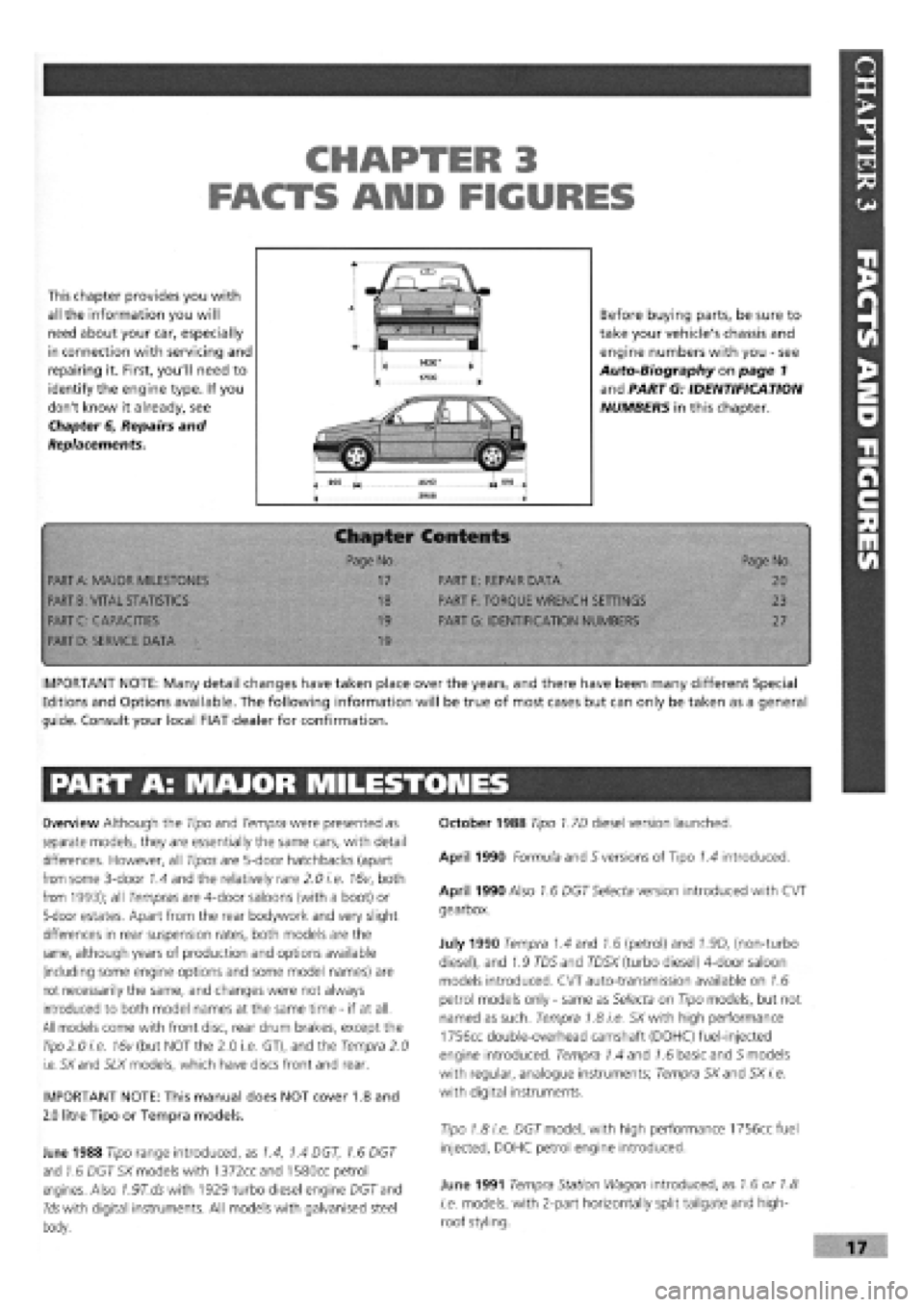
CHAPTER 3
FACTS ARID FIGURES
This chapter provides you with
all the information you will
need about your car, especially
in connection with servicing and
repairing it. First, you'll need to
identify the engine type. If you
don't know it already, see
Chapter 6, Repairs and
Replacements.
Before buying parts, be sure to
take your vehicle's chassis and
engine numbers with you
-
see
Auto-Biography on page 1
and PART G: IDENTIFICATION
NUMBERS in this chapter.
Chapter Contents
• -< Page No. Page No.
PART
A:
MAJOR MILESTONES 17 PART E: REPAIR DATA 20
PART
B:
VITAL STATISTICS 18 PART
F:
TORQUE WRENCH SETTINGS 23
PART C: CAPACITIES 19 PART G: IDENTIFICATION NUMBERS 27
PART
D:
SERVICE DATA 19
•
IMPORTANT NOTE: Many detail changes have taken place over the years, and there have been many different Special
Editions and Options available. The following information will be true of most cases but can only be taken as a general
guide. Consult your local FIAT dealer for confirmation.
PART A: MAJOR MILESTONES
Overview Although the Tipo and Tempra were presented as
separate models, they are essentially the same cars, with detail
differences. However, all Tipos are 5-door hatchbacks (apart
from some 3-door 1.4 and the relatively rare 2.0 i.e. 16v, both
from 1993); all Tempras are 4-door saloons (with a boot) or
5-door estates. Apart from the rear bodywork and very slight
differences in rear suspension rates, both models are the
same, although years of production and options available
(including some engine options and some model names) are
not necessarily the same, and changes were not always
introduced to both model names at the same time
-
if at all.
All models come with front disc, rear drum brakes, except the
Tipo
2.0 i.e. 16v (but NOT the 2.0 i.e. GT), and the Tempra 2.0
i.e. SXand SLX models, which have discs front and rear.
IMPORTANT NOTE: This manual does NOT cover 1.8 and
2.0 litre Tipo or Tempra models.
June 1988 Tipo range introduced, as 1.4, 1.4 DGT, 1.6 DGT
and 1.6 DGT SX models with 1372ccand 1580cc petrol
engines. Also 7.97".dswith 1929 turbo diesel engine DGT and
Ids with digital instruments. All models with galvanised steel
body.
October 1988 Tipo 1.7D diesel version launched.
April 1990 Formula and S versions of Tipo 1.4 introduced.
April 1990 Also 1.6 DGT Selecta version introduced with CVT
gearbox.
July 1990 Tempra 1.4 and 1.6 (petrol) and 1.9D, (non-turbo
diesel), and 1.9 TD5 and TD5X (turbo diesel) 4-door saloon
models introduced. CVT auto-transmission available on 1.6
petrol models only
-
same as Selecta on Tipo models, but not
named as such. Tempra 1.8 i.e. SX with high performance
1756cc double-overhead camshaft (DOHC) fuel-injected
engine introduced. Tempra 1.4 and 1.6 basic and 5 models
with regular, analogue instruments; Tempra SXand SX i.e.
with digital instruments.
Tipo 1.8 i.e. DGT model, with high performance 1756cc fuel
injected, DOHC petrol engine introduced.
June 1991 Tempra Station Wagon introduced, as 1.6 or 1.8
i.e. models, with 2-part horizontally split tailgate and high-
roof styling.
Page 34 of 171
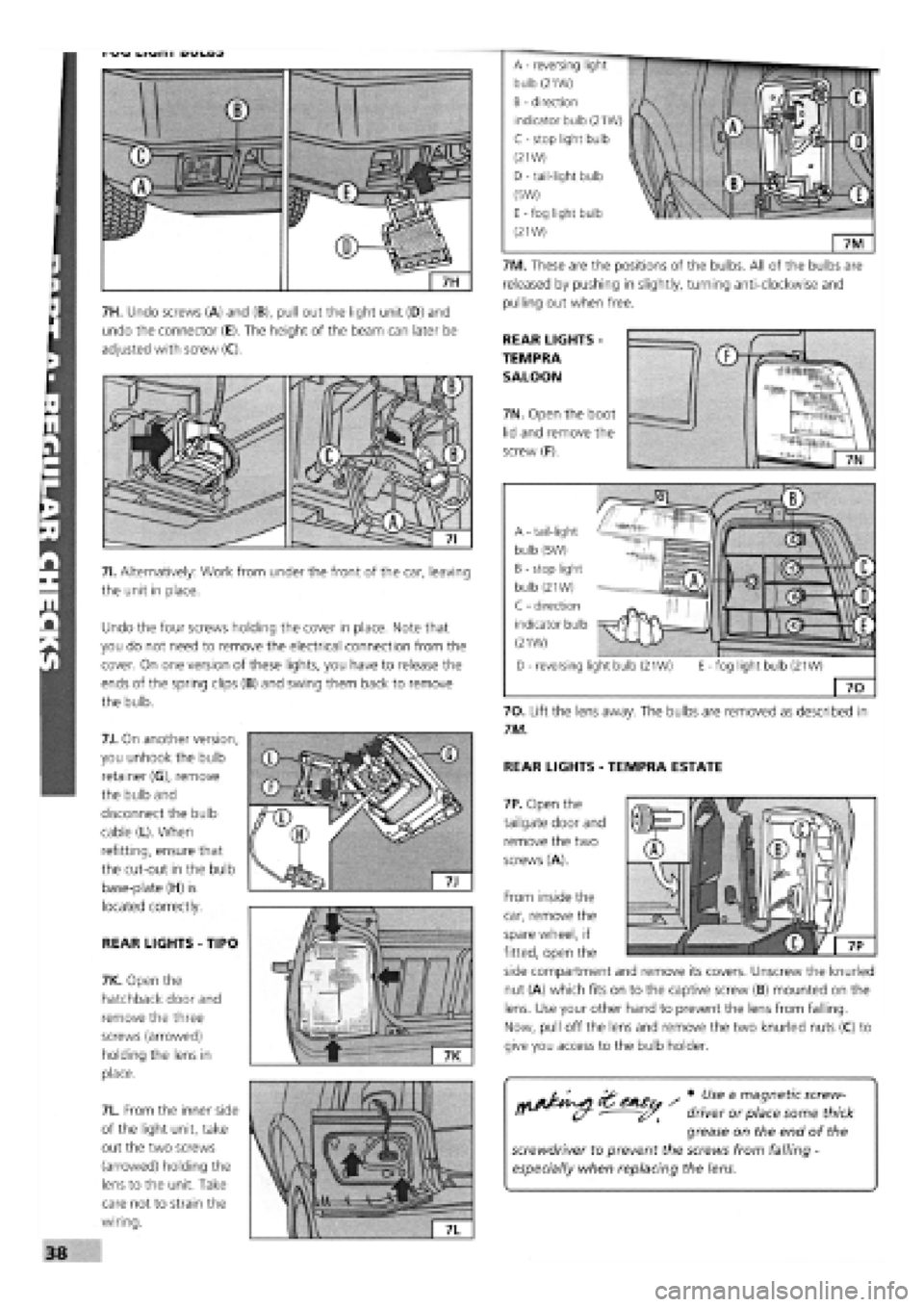
ruvj
uivjh I
uuluj
^ Use a magnetic screw-
driver or place some thick
grease on the end of the
screwdriver to prevent the screws from falling
-
especially when replacing the lens.
7H. Undo screws (A) and (B), pull out the light unit (D) and
undo the connector (E). The height of the beam can later be
adjusted with screw (C).
71. Alternatively: Work from under the front of the car, leaving
the unit in place.
Undo the four screws holding the cover in place. Note that
you do not need to remove the electrical connection from the
cover. On one version of these lights, you have to release the
ends of the spring clips (B) and swing them back to remove
the bulb.
7J. On another version,
you unhook the bulb
retainer (G), remove
the bulb and
disconnect the bulb
cable (L). When
refitting, ensure that
the cut-out in the bulb
base-plate (H) is
located correctly.
REAR LIGHTS
-
TIPO
7K. Open the
hatchback door and
remove the three
screws (arrowed)
holding the lens in
place.
7L. From the inner side
of the light unit, take
out the two screws
(arrowed) holding the
lens to the unit. Take
care not to strain the
wiring.
7M. These are the positions of the bulbs. All of the bulbs are
released by pushing in slightly, turning anti-clockwise and
pulling out when free.
REAR LIGHTS -
TEMPRA
SALOON
7N. Open the boot
lid and remove the
screw (F).
-fog light bulb (21W)
70
70. Lift the lens away. The bulbs are removed as described in
7M.
REAR LIGHTS
-
TEMPRA ESTATE
7P. Open the
tailgate door and
remove the two
screws (A).
From inside the
car, remove the
spare wheel, if
fitted, open the
side compartment and remove its covers. Unscrew the knurled
nut (A) which fits on to the captive screw (B) mounted on the
lens. Use your other hand to prevent the lens from falling.
Now, pull off the lens and remove the two knurled nuts (C) to
give you access to the bulb holder.
A - tail-light
bulb (5W)
B - stop light
bulb (21W)
C - direction
indicator bulb
(21W)
D - reversing light bulb (21W) E
A - reversing
bulb (21W)
B - direction
indicator bulb (21W)
C - stop light bulb
(21W)
D
-
tail-light bulb
(5W)
E - fog light bulb
(21W)
Page 58 of 171
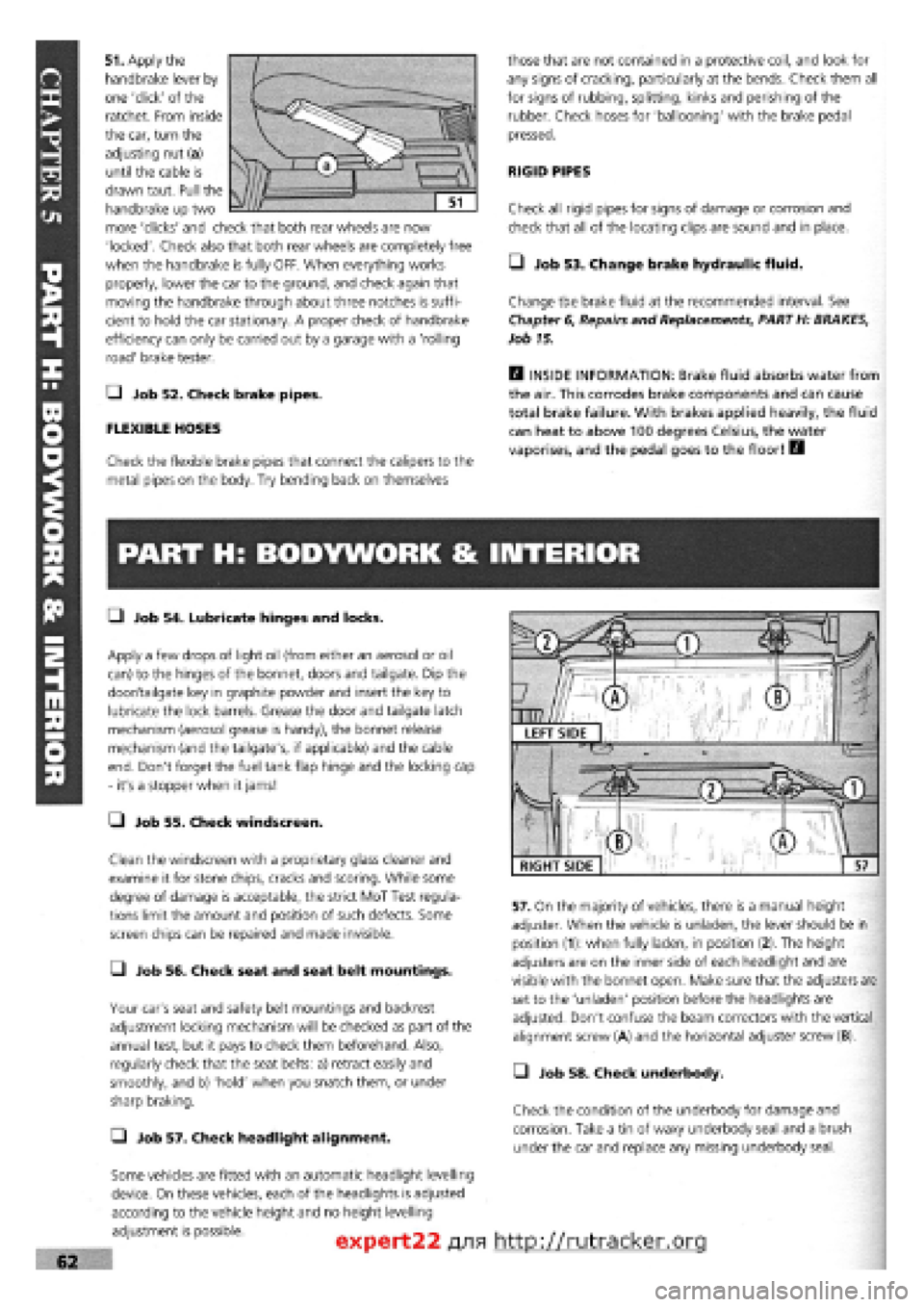
51. Apply the
handbrake lever by
one 'click' of the
ratchet. From inside
the car, turn the
adjusting nut (a)
until the cable is
drawn taut. Pull the
handbrake up two
more 'clicks' and check that both rear wheels are now
'locked'. Check also that both rear wheels are completely free
when the handbrake is fully OFF. When everything works
properly, lower the car to the ground, and check again that
moving the handbrake through about three notches is suffi-
cient to hold the car stationary. A proper check of handbrake
efficiency can only be carried out by a garage with a 'rolling
road' brake tester.
Q Job 52. Check brake pipes.
FLEXIBLE HOSES
Check the flexible brake pipes that connect the calipers to the
metal pipes on the body. Try bending back on themselves
those that are not contained in a protective coil, and look for
any signs of cracking, particularly at the bends. Check them all
for signs of rubbing, splitting, kinks and perishing of the
rubber. Check hoses for 'ballooning' with the brake pedal
pressed.
RIGID PIPES
Check all rigid pipes for signs of damage or corrosion and
check that all of the locating clips are sound and in place.
• Job 53. Change brake hydraulic fluid.
Change the brake fluid at the recommended interval. See
Chapter
6,
Repairs and Replacements, PART H: BRAKES,
Job 15.
H INSIDE INFORMATION: Brake fluid absorbs water from
the air. This corrodes brake components and can cause
total brake failure. With brakes applied heavily, the fluid
can heat to above 100 degrees Celsius, the water
vaporises, and the pedal goes to the floor! B
PART H: BODYWORK & INTERIOR
• Job 54. Lubricate hinges and locks.
Apply a few drops of light oil (from either an aerosol or oil
can) to the hinges of the bonnet, doors and tailgate. Dip the
door/tailgate key in graphite powder and insert the key to
lubricate the lock barrels. Grease the door and tailgate latch
mechanism (aerosol grease is handy), the bonnet release
mechanism (and the tailgate's, if applicable) and the cable
end. Don't forget the fuel tank flap hinge and the locking cap
- it's a stopper when it jams!
• Job 55. Check windscreen.
Clean the windscreen with a proprietary glass cleaner and
examine it for stone chips, cracks and scoring. While some
degree of damage is acceptable, the strict MoT Test regula-
tions limit the amount and position of such defects. Some
screen chips can be repaired and made invisible.
• Job 56. Check seat and seat belt mountings.
Your car's seat and safety belt mountings and backrest
adjustment locking mechanism will be checked as part of the
annual test, but it pays to check them beforehand. Also,
regularly check that the seat belts: a) retract easily and
smoothly, and b) 'hold' when you snatch them, or under
sharp braking.
Q Job 57. Check headlight alignment.
Some vehicles are fitted with an automatic headlight levelling
device. On these vehicles, each of the headlights is adjusted
according to the vehicle height and no height levelling
adjustment is possible.
57. On the majority of vehicles, there is a manual height
adjuster. When the vehicle is unladen, the lever should be in
position (1): when fully laden, in position (2). The height
adjusters are on the inner side of each headlight and are
visible with the bonnet open. Make sure that the adjusters are
set to the 'unladen' position before the headlights are
adjusted. Don't confuse the beam correctors with the vertical
alignment screw (A) and the horizontal adjuster screw (B).
• Job 58. Check underbody.
Check the condition of the underbody for damage and
corrosion. Take a tin of waxy underbody seal and a brush
under the car and replace any missing underbody seal.
expert22 fl/ia http://rutracker.org
RIGHT SIDE
Page 107 of 171

Job 6. Hatchback wiper motor -
replacement.
• Step 3: Disconnect the drive cable from the back of
speedometer.
• Step 4: From under the bonnet, uncouple the two cable
halves
from the centre connector and withdraw the
speedometer section through the bulkhead.
Q Step 5: Disconnect the lower end of the cable from the
gearbox drive and remove it.
G Step 6: Follow the reverse procedure to refit the cable,
being
careful to run the cable as straight as possible, avoiding
sharp bends.
Job 5. Windscreen wiper motor -
replacement.
Q Step 1: Disconnect the battery negative (earth) terminal.
Q Step 2: Note the position of the wiper blades on the
screen. Remove the two windscreen wiper arms and then the
grille
cover.
Q Step 3: Unplug the electrical connector and undo the
four mounting screws (arrowed). Remove the complete
assembly.
Q Step 4: Uncouple the linkage rods from the motor
(arrowed).
Q Step 5: Remove the motor by undoing the three
mounting bolts.
Q Step 6: Note the location of
-
and wiring for
-
these
components.
Q Step 7: Refitting is the reverse of removal, but take care
to position
the wiper arms as you found them after first
making
sure the motor is 'parked'.
IMPORTANT NOTE: For a view of the headlight wiper
motor (where fitted) refer to Job 7. Step 3.
PART A: TIPO MODELS
• Step A1: This
is a view of the
components for
the Tipo rear
wiper.
• Step A2:
Undo the securing
nut and remove
the wiper arm.
• Step A3: Open the tailgate and pull the weather strip
away from the top of the interior trim panel.
• Step A4: Remove the five screws holding the trim in
place
-
three of these also secure the lock.
Q Step A5: Carefully lever out the trim fixing clips freeing
the trim. Unplug the wiring to the tailgate lock motor (if fitted)
and remove the lock/trim panel assembly.
• Step A6: Unplug the wires from the wiper motor, undo
the three screws holding the motor in place and remove the
motor assembly.
• Step A7: Check that the seal in the tailgate wiper shaft
hole is in good condition and then start refitting in reverse
order. Make sure the wiper motor is 'parked' before fitting the
arm and blade.
PART B: TEMPRA MODELS
• Step B1: This shows the layout of the Tempra rear wiper.
Q Step B2: Disconnect the
battery earth lead. Undo the
securing nut and remove the
wiper arm.
Q Step B3: Remove the
motor cover shield.
Q Step B4: Disconnect the
wiring plug and washer
tubing.
• Step B5: From outside,
undo and remove the wiper
shaft nut and retrieve the spacer/seal.
Page 108 of 171
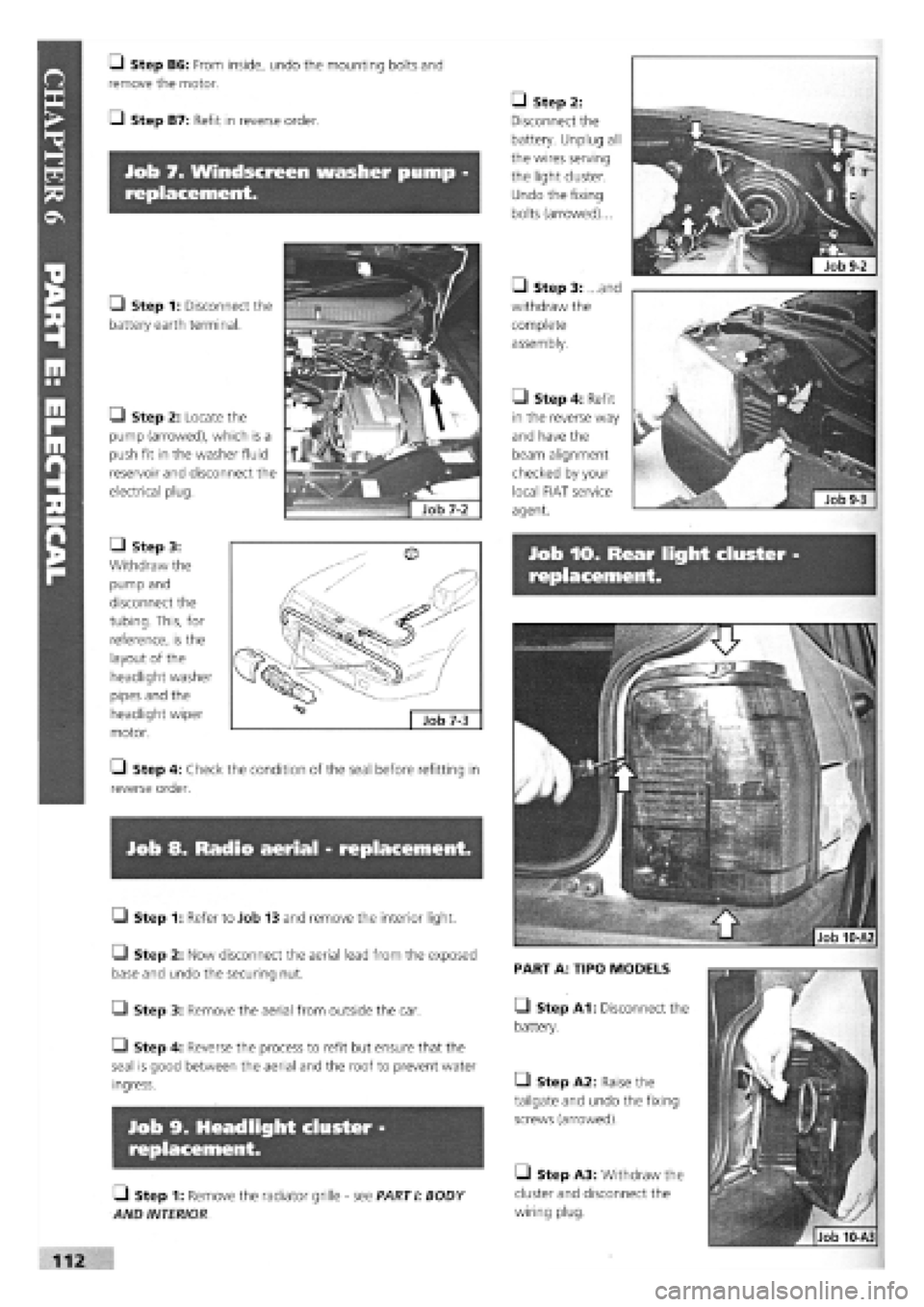
Job
9-2
Job 7. Windscreen washer pump -
replacement.
Job 10. Rear light cluster
replacement.
Job 8. Radio aerial - replacement.
• Step 1: Refer to Job 13 and remove the interior light.
Q Step 2: Now disconnect the aerial lead from the exposed
base and undo the securing nut.
• Step 3: Remove the aerial from outside the car.
Q Step 4: Reverse the process to refit but ensure that the
seal is good between the aerial and the roof to prevent water
ingress.
Job 9. Headlight cluster -
replacement.
• Step 1: Remove the radiator grille
-
see PARTI: BODY
AND INTERIOR
PART A: TIPO MODELS
O Step A1: Disconnect the
battery.
• Step A2: Raise the
tailgate and undo the fixing
screws (arrowed).
• Step A3: Withdraw the
cluster and disconnect the
wiring plug.
• Step 2:
Disconnect the
battery. Unplug all
the wires serving
the light cluster.
Undo the fixing
bolts (arrowed)...
• Step 3: ...and
withdraw the
complete
assembly.
Q Step B6: From inside, undo the mounting bolts and
remove the motor.
Q Step B7: Refit in reverse order.
O Step 1: Disconnect the
battery earth terminal.
• Step 2: Locate the
pump (arrowed), which is a
push fit in the washer fluid
reservoir and disconnect the
electrical plug.
• Step 4: Refit
in the reverse way
and have the
beam alignment
checked by your
local FIAT service
agent.
• Step 3:
Withdraw the
pump and
disconnect the
tubing. This, for
reference, is the
layout of the
headlight washer
pipes and the
headlight wiper
motor.
• Step 4: Check the condition of the seal before refitting in
reverse order.
Page 139 of 171

PART I: BODY AMD INTERIOR
PART 1: Contents
Job 1. Bonnet
-
removal and refitting. Job 8. Tempra boot lid locking mechanism
-
removal and
Job 2. Bonnet locking mechanism
-
replacement and refitting.
adjustment. Job 9. Front bumper and grille
-
removal and refitting.
Job 3. Radiator grille
-
removal and refitting. Job 10. Rear bumper
-
removal and refitting.
Job 4. Tipo/Tempra tailgate
-
removal and refitting. Job 11. Door trim panel
-
removal and refitting.
Job 5. Tipo tailgate locking mechanism
-
removal and Job 12. Door component
-
removal and replacement
refitting. Job 13. Door removal, replacement and adjustment.
Job 6. Tempra estate tailgate locking mechanism
-
removal Job 14. Door mirror
-
replacement.
and refitting. Job 15. Sun roof
-
removal and refitting.
Job 7. Tempra boot lid
-
removal and refitting. Job 16. Front seats
-
removal and refitting.
-Job 17. Rear seats
-
removal and refitting.
Job 1. Bonnet - removal and
refitting.
Job 2. Bonnet locking mechanism
- replacement and adjustment.
• Step 1: Note the bonnet hinges, support and stops.
G Step 2: Use the prop and hold the bonnet open. Outline
the hinge positions on the bonnet with masking tape for
accurate refitment.
G Step 3: Ask an assistant to support the bonnet. Undo the
two hinge fixing bolts. Carefully lift the bonnet clear.
if refitting the bonnet, put a
piece of cloth under each
rear corner to protect the bodywork.
• Step 1: This drawing shows left and right hand drive
layouts. Select which is right for your car.
• Step 2: The two screws (illustration Job 2-3 arrowed)
used to fix the locking pin/safety catch assembly to the bonnet
are also used for fore and aft adjustment. This is best done a
little at a time until smooth operation is achieved.
• Step 3: Height
adjustment (levelling with
the wings) is achieved by
screwing the bump stops
(inset, arrowed) up or
down. Then slacken the
G Step 5: When refitting, tighten the bolts just enough to
grip the hinges, then carefully lower the bonnet to check for
correct alignment all round
-
equal gapping.
When the alignment is satisfactory, tighten the bolts to their
correct torque, See Chapter 3, Facts and Figures
[G Step 4: To remove the lock/striker assembly, separate the
cable eyelet from the operating lever hook, see illustration Job
2-1, parts 13 and 14
1 - lock/striker assembly, front panel 2 - locking pin/safety catch, bonnet 3 - release lever. (Also fitted other side, some R/H drive cars) 4 - cable, L/H drive 5 - cable, R/H drive
and secondary cable, R/H drive 7 - screw 8
-
washer 9 - bolt 10 - bolt
11 - cable clip 12 - cable fixing screw 13 - cable eyelet 14 - operating lever hook Job 2-1
locking nut (hidden
behind the locking pin
spring) and screw the
locking pin up or down
until the bonnet will shut
when dropped from 30 cm height and then have no
movement on the lock. Don't forget to tighten the locknut.
Page 140 of 171
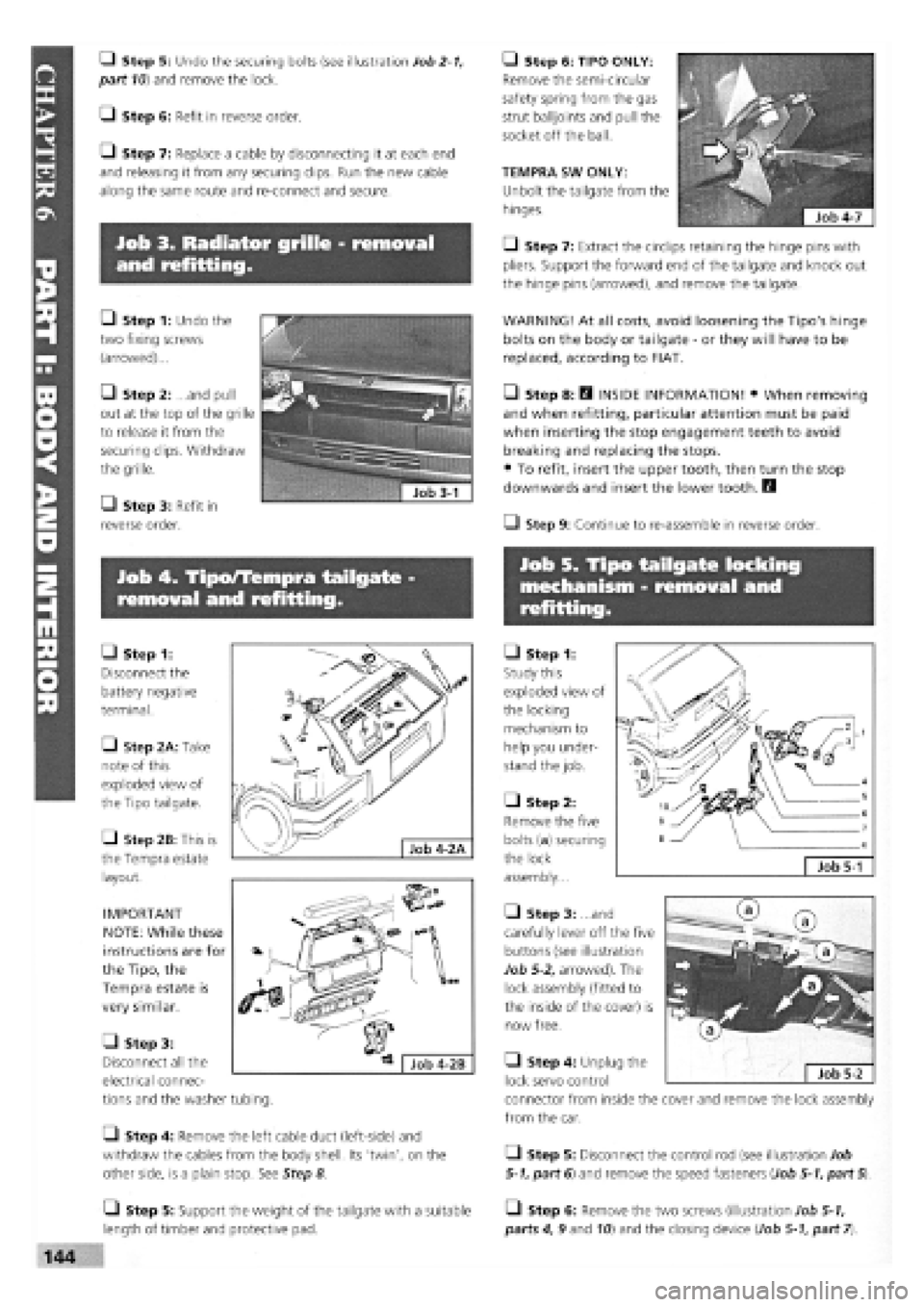
Job 3. Radiator grille - removal
and refitting.
Job 5. Tipo tailgate locking
mechanism - removal and
refitting.
Job 4. Tipo/Tempra tailgate -
removal and refitting.
Q Step 5: Undo the securing bolts (see illustration Job
2-1,
part
10)
and remove the lock.
Q Step 6: Refit in reverse order.
Q Step 7: Replace a cable by disconnecting it at each end
and releasing it from any securing clips. Run the new cable
along the same route and re-connect and secure.
• Step 1: Undo the
two fixing screws
(arrowed)...
Q Step 2: ...and pull
out at the top of the grille
to release it from the
securing clips. Withdraw
the grille.
• Step 3: Refit in
reverse order.
• Step 1:
Disconnect the
battery negative
terminal.
• Step 2A: Take
note of this
exploded view of
the Tipo tailgate.
• Step 2B: This is
the Tempra estate
layout.
IMPORTANT
NOTE: While these
instructions are for
the Tipo, the
Tempra estate is
very similar.
• Step 1:
Study this
exploded view of
the locking
mechanism to
help you under-
stand the job.
• Step 2:
Remove the five
bolts (a) securing
the lock
assembly...
• Step 3: ...and
carefully lever off the five
buttons (see illustration
Job
5-2,
arrowed). The
lock assembly (fitted to
the inside of the cover) is
now free.
• Step 6: TIPO ONLY:
Remove the semi-circular
safety spring from the gas
strut balljoints and pull the
socket off the ball.
TEMPRA SW ONLY:
Unbolt the tailgate from the
hinges.
• Step 7: Extract the circlips retaining the hinge pins with
pliers. Support the forward end of the tailgate and knock out
the hinge pins (arrowed), and remove the tailgate.
WARNING! At all costs, avoid loosening the Tipo's hinge
bolts on the body or tailgate
-
or they will have to be
replaced, according to FIAT.
• Step 8: H INSIDE INFORMATION! • When removing
and when refitting, particular attention must be paid
when inserting the stop engagement teeth to avoid
breaking and replacing the stops.
• To refit, insert the upper tooth, then turn the stop
downwards and insert the lower tooth. B
Q Step 9: Continue to re-assemble in reverse order.
Job 5-1
• Step 3:
Disconnect all the
electrical connec-
tions and the washer tubing.
• Step 4: Remove the left cable duct (left-side) and
withdraw the cables from the body shell. Its 'twin', on the
other side, is a plain stop. See Step 8
• Step 4: Unplug the
lock servo control
connector from inside the cover and remove the lock assembly
from the car.
Q Step 5: Disconnect the control rod (see illustration Job
5-1,
part 6) and remove the speed fasteners (Job
5-1,
part
5).
• Step 5: Support the weight of the tailgate with a suitable
length of timber and protective pad.
• Step 6: Remove the two screws (illustration Job
5-1,
parts 4, 9 and
10)
and the closing device (Job
5-1,
part
7).
Page 141 of 171
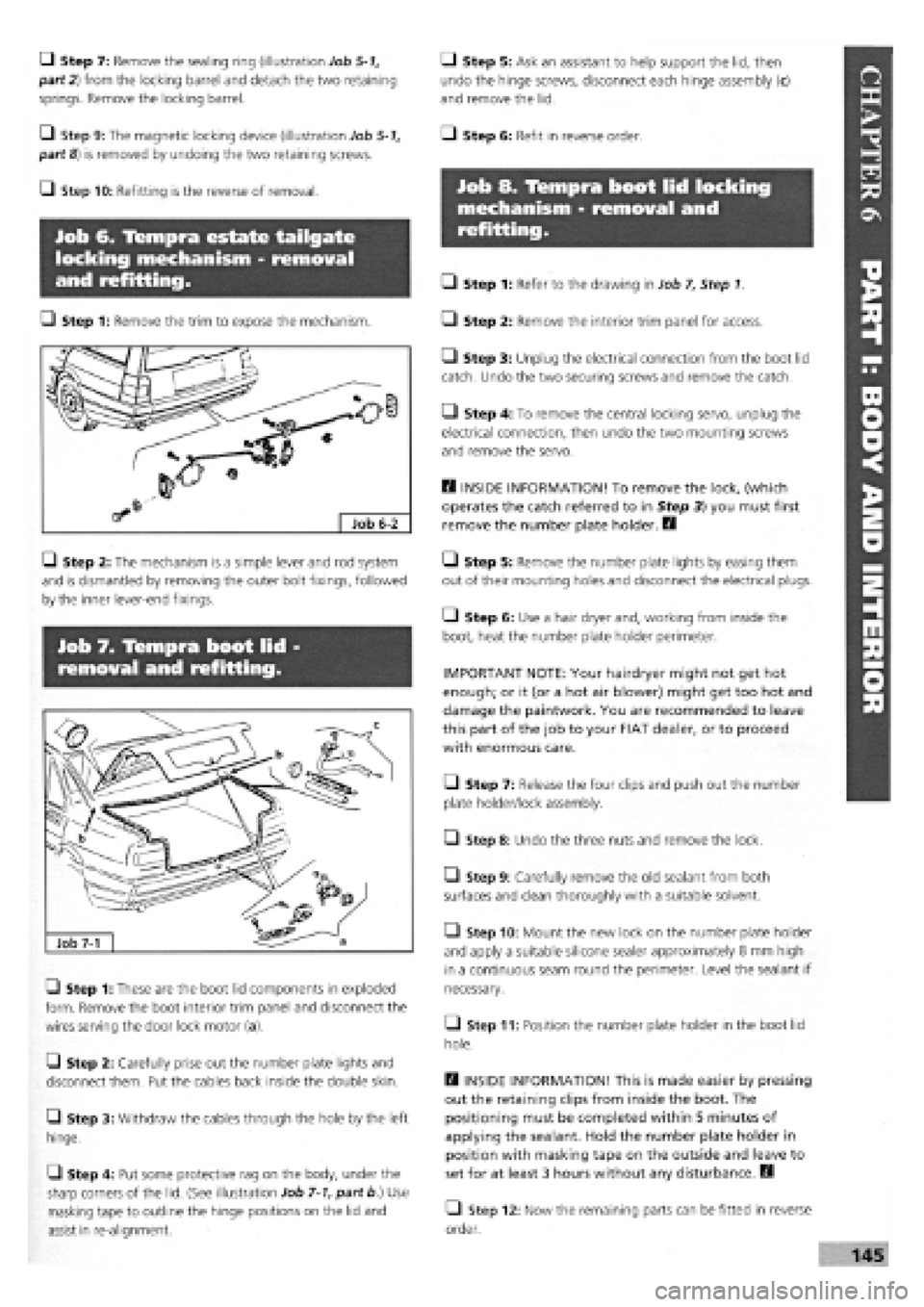
Q Step 7: Remove the sealing ring (illustration Job
5-1,
part 2) from the locking barrel and detach the two retaining
springs. Remove the locking barrel.
Q Step 9: The magnetic locking device (illustration Job
5-1,
part 8) is removed by undoing the two retaining screws.
Q Step 10: Refitting is the reverse of removal.
Job 6. Tempra estate tailgate
locking mechanism - removal
and refitting.
Q Step 1: Remove the trim to expose the mechanism.
G Step 2: The mechanism is a simple lever and rod system
and is dismantled by removing the outer bolt fixings, followed
by the inner lever-end fixings.
Job 7. Tempra boot lid -
removal and refitting.
Q Step 1: These are the boot lid components in exploded
form. Remove the boot interior trim panel and disconnect the
wires serving the door lock motor (a).
G Step 2: Carefully prise out the number plate lights and
disconnect them. Put the cables back inside the double skin.
Q Step 3: Withdraw the cables through the hole by the left
hinge.
L) Step 4: Put some protective rag on the body, under the
sharp corners of the lid. (See illustration Job
7-1,
part b.) Use
masking tape to outline the hinge positions on the lid and
assist in re-alignment.
Q Step 5: Ask an assistant to help support the lid, then
undo the hinge screws, disconnect each hinge assembly (c)
and remove the lid.
Q Step 6: Refit in reverse order.
Job 8. Tempra boot lid locking
mechanism - removal and
refitting.
Q Step 1: Refer to the drawing in Job 7, Step 1.
• Step 2: Remove the interior trim panel for access.
Q Step 3: Unplug the electrical connection from the boot lid
catch. Undo the two securing screws and remove the catch.
Q Step 4: To remove the central locking servo, unplug the
electrical connection, then undo the two mounting screws
and remove the servo.
Q INSIDE INFORMATION! To remove the lock, (which
operates the catch referred to in Step 3) you must first
remove the number plate holder. B
Q Step 5: Remove the number plate lights by easing them
out of their mounting holes and disconnect the electrical plugs.
Gl Step 6: Use a hair dryer and, working from inside the
boot, heat the number plate holder perimeter.
IMPORTANT NOTE: Your hairdryer might not get hot
enough; or it (or a hot air blower) might get too hot and
damage the paintwork. You are recommended to leave
this part of the job to your FIAT dealer, or to proceed
with enormous care.
• Step 7: Release the four clips and push out the number
plate holder/lock assembly.
• Step 8: Undo the three nuts and remove the lock.
Q Step 9: Carefully remove the old sealant from both
surfaces and clean thoroughly with a suitable solvent.
• Step 10: Mount the new lock on the number plate holder
and apply a suitable silicone sealer approximately 8 mm high
in a continuous seam round the perimeter. Level the sealant if
necessary.
• Step 11: Position the number plate holder in the boot lid
hole.
H INSIDE INFORMATION! This is made easier by pressing
out the retaining clips from inside the boot. The
positioning must be completed within 5 minutes of
applying the sealant. Hold the number plate holder in
position with masking tape on the outside and leave to
set for at least 3 hours without any disturbance. D
Q Step 12: Now the remaining parts can be fitted in reverse
order.
Page 142 of 171
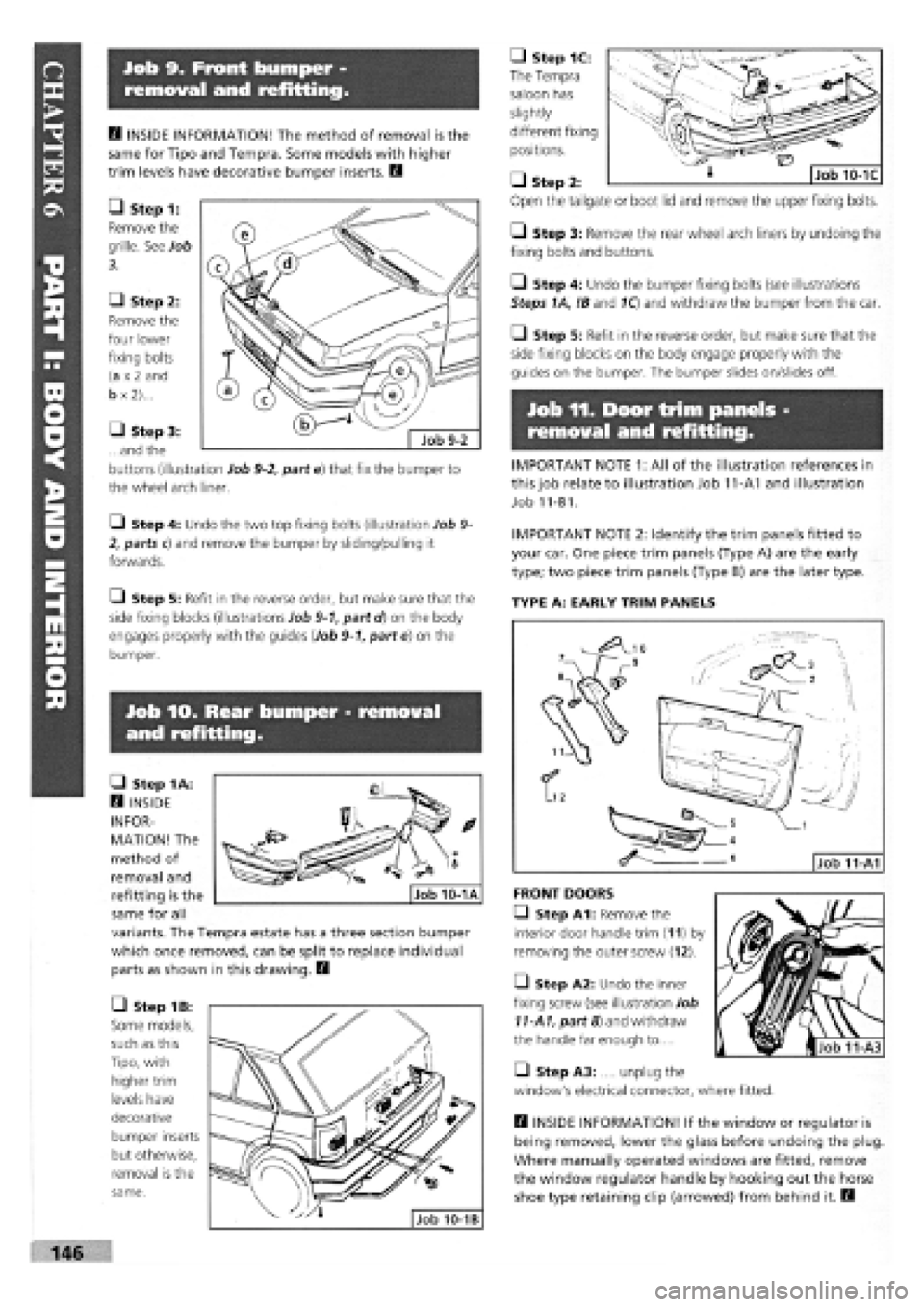
Job 9. Front bumper -
removal and refitting.
• Step 1C:
The Tempra
saloon has
slightly
different fixing
positions.
• Step
Open the
Q Step 3: Remove the rear wheel arch liners by undoing the
fixing bolts and buttons.
• Step 4: Undo the bumper fixing bolts (see illustrations
Steps 1A, !B and 1Q and withdraw the bumper from the car.
• Step 5: Refit in the reverse order, but make sure that the
side fixing blocks on the body engage properly with the
guides on the bumper. The bumper slides on/slides off.
Job 11. Door trim panels -
removal and refitting.
IMPORTANT NOTE 1: All of the illustration references in
this job relate to illustration Job 11-A1 and illustration
Job 11-B1.
IMPORTANT NOTE 2: Identify the trim panels fitted to
your car. One piece trim panels (Type A) are the early
type; two piece trim panels (Type B) are the later type.
TYPE A: EARLY TRIM PANELS
Job lO. Rear bumper - removal
and refitting.
H INSIDE INFORMATION! The method of removal is the
same for Tipo and Tempra. Some models with higher
trim levels have decorative bumper inserts. B
• Step 1:
Remove the
grille. See Job
3.
• Step 2:
Remove the
four lower
fixing bolts
(a
x 2
and
b
x
2)...
• Step 3:
...and the
buttons (illustration Job
9-2,
part e) that fix the bumper to
the wheel arch liner.
Q Step 4: Undo the two top fixing bolts (illustration Job
9-
2, parts c) and remove the bumper by sliding/pulling it
forwards.
Q Step 5: Refit in the reverse order, but make sure that the
side fixing blocks (illustrations Job
9-1,
part d) on the body
engages properly with the guides (Job
9-1,
part e) on the
bumper.
• Step 1A:
Q INSIDE
INFOR-
MATION! The
method of
removal and
refitting is the
same for all
variants. The Tempra estate has a three section bumper
which once removed, can be split to replace individual
parts as shown in this drawing. B
• Step 1B:
Some models,
such as this
Tipo, with
higher trim
levels have
decorative
bumper inserts
but otherwise,
removal is the
same.
FRONT DOORS
• Step A1: Remove the
interior door handle trim (11) by
removing the outer screw (12).
• Step A2: Undo the inner
fixing screw (see illustration Job
11-A1,
part 8) and withdraw
the handle far enough to....
• Step A3: .... unplug the
window's electrical connector, where fitted.
B INSIDE INFORMATION! If the window or regulator is
being removed, lower the glass before undoing the plug
Where manually operated windows are fitted, remove
the window regulator handle by hooking out the horse
shoe type retaining clip (arrowed) from behind it. B
2:
tailgate or boot lid and remove the upper fixing bolts.
MMBBMHHi 146